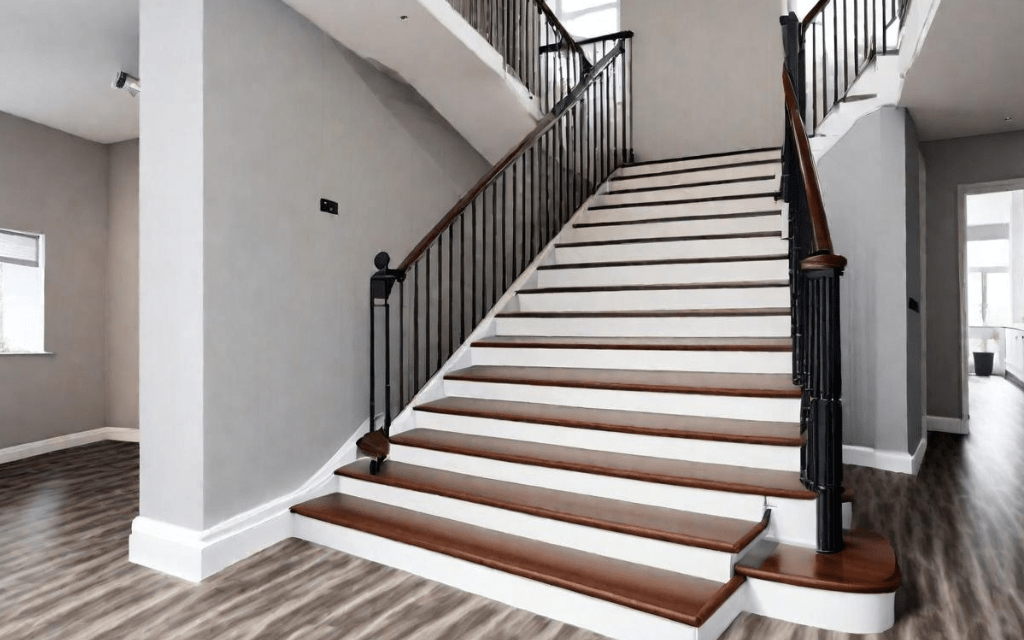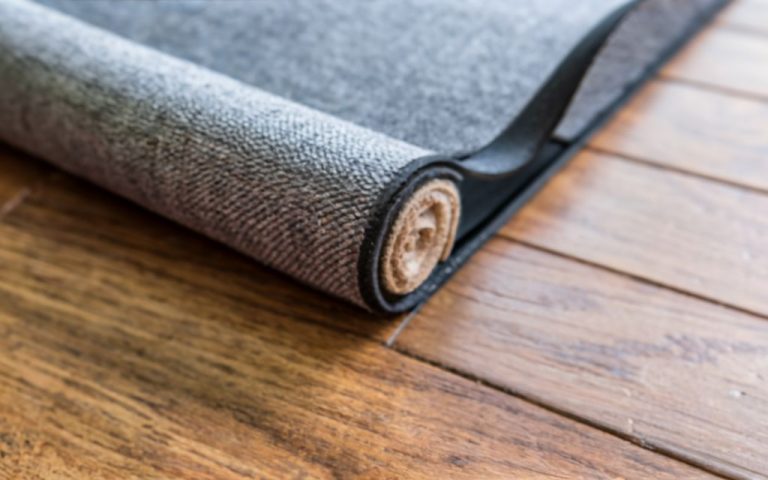How to Install Vinyl Flooring on Stairs With Nosing?
Installing Vinyl Flooring on stairs is a complex process. And if you need to add nosing it needs also the best understanding to do it. But we all want to do with good results. So, how to install vinyl flooring on stairs with nosing? this is our discussion point today.
By following a few simple steps, you can ensure a smooth and successful installation process of stairs. In this guide, we’ll outline the necessary steps to install vinyl flooring on stairs with nosing, helping you achieve a stylish and practical solution for your home.

First Selecting Best Vinyl Flooring for Stairs…
If you plan to install vinyl flooring on your stairs with nosing, it’s important to understand the different types of vinyl flooring available in the market.
Each type of vinyl flooring has its own unique characteristics, benefits, and installation requirements. But, the best is to use Rigid Core Vinyl for its durability and stability.
Knowing the differences between these types can help you make an informed decision when choosing the right vinyl flooring for your stairs.
Here is a the different types of vinyl flooring suitable for stairs, followed by a recommendation for the best option to use on stairs.
| Type | Benefits | Installation | Suitability for Stairs |
|---|---|---|---|
| Rigid Core Vinyl | Enhanced dimensional stability, withstands temperature changes, easy click-lock installation | Click-lock installation system | High, due to durability and stability |
| Luxury Vinyl Tile (LVT) | Resilient, low maintenance, easy replacement of damaged tiles | Tile format | High, due to resilience and design versatility |
| Vinyl Plank Flooring | Moisture-resistant, diverse design possibilities, simple tongue-and-groove installation | Tongue-and-groove system | High, due to moisture resistance and easy installation |
| Sheet Vinyl | Resilient, waterproof, easy to clean and maintain, variety of designs | Seamless installation | Moderate, may be less ideal for high-traffic stair areas |
Preparing The Staircase For Installation
Preparing the staircase for installing vinyl flooring with nosing is a crucial step to ensure a successful and long-lasting outcome. This involves a series of essential tasks, including measuring the stairs, assessing their condition, and prepping the surface to provide a stable foundation for the new flooring.
Measuring The Stairs
Before installation, accurate measurements of the stairs are essential for calculating the amount of vinyl flooring and nosing required. Begin by measuring the width and depth of each tread and the height and length of each riser. Take note of any irregularities or variations as these measurements will inform the cutting and fitting of the flooring material.
Assessing The Condition Of The Stairs
Thoroughly inspect the stairs for any signs of damage, wear, or structural issues that may need addressing before installation. Ensure that the nosing is securely attached and that there are no loose or damaged components that could affect the integrity of the new flooring.
Cleaning And Leveling The Surface
Before installation, clean the stair surface to remove any dirt, residue, or imperfections that may affect the adhesion of the new flooring. Additionally, ensure that the stair surface is level and free from protrusions or inconsistencies that could create unevenness in the finished result.
Adding Underlayment If Necessary
If the stairs exhibit significant irregularities or if additional cushioning and sound insulation are desired, consider adding underlayment to provide a smoother surface and enhance the comfort and performance of the vinyl flooring. This step can contribute to a more professional and durable finish.
Gather The Necessary Tools And Materials
Gathering the necessary tools and materials is the first step in installing vinyl flooring on stairs with nosing. Having the right equipment and supplies on hand will ensure a smooth and successful installation process. Below are the essential items you will need to get started.
Here are the necessary tools and materials for installing vinyl flooring on stairs with nosing:
| Material/Tool | Description |
|---|---|
| Vinyl Flooring | Tools like a tape measure and a straight edge for accurate measurements ensure a precise and seamless installation. |
| Nosing Strips | Strips are designed to provide a finished, professional appearance to stair edges and ensure slip-resistant transitions. |
| Adhesive | High-quality adhesive formulated for use with vinyl flooring to ensure a secure and lasting bond. |
| Cutting Tools | Sharp tools such as a utility knife or vinyl cutter are required for accurately trimming the vinyl flooring. |
| Measuring Tools | Tools like a tape measure and a straight edge for accurate measurements ensure a precise and seamless installation. |

Step-by-step Vinyl Stairs Installation Guide
Now, that you have gathered all the materials and prepared the staircase, you should start the main installation process. Here’s a step-by-step installation guide for vinyl flooring on stairs with nosing:
Step1: Cutting The Vinyl Flooring To Size
Before you get started with the installation, you’ll need to measure your stairs and cut the vinyl flooring to size. Using a tape measure, carefully measure the dimensions of each stair tread and riser.
Transfer these measurements to your vinyl flooring and use a utility knife to cut the vinyl to the appropriate size. Ensure that each piece is cut accurately for a perfect fit.
Step2: Applying Adhesive To The Stairs
Once the vinyl flooring is cut to size, it’s time to apply adhesive to the stairs. Use a high-quality adhesive that is specifically designed for use with vinyl flooring. Apply an even layer of adhesive to each stair tread and riser, following the manufacturer’s instructions closely. This will ensure proper adhesion and a long-lasting finish.
Step3: Installing Nosing Strips
If your stairs have nosing, you’ll need to install nosing strips before attaching the vinyl flooring. Measure and cut the nosing strips to match the dimensions of your stairs. Apply adhesive to the nosing and carefully place the strips in position, ensuring that they align perfectly with the edge of each tread.
Step4: Attaching Vinyl Flooring Onto The Stairs
Once the adhesive and nosing strips are in place, carefully position the vinyl flooring onto the stairs, starting from the bottom and working your way up. Press the flooring firmly onto the adhesive, ensuring a secure bond. Take your time to align the flooring accurately, smoothing out any air bubbles or wrinkles as you go.
Step5: Securing The Edges
After attaching the vinyl flooring to the stairs, it’s important to secure the edges for a neat and professional finish. Use a hand roller to press down the edges, ensuring that they adhere firmly to the nosing and stair surfaces.
This will help prevent lifting and ensure that the vinyl flooring stays in place for years to come.
Blending The Nosing With The Flooring
Blending the nosing with the flooring on stairs is essential for a cohesive and aesthetically pleasing look. When installing vinyl flooring with nosing on stairs, it’s crucial to ensure that the nosing seamlessly integrates with the flooring material.
Choosing Matching Colors Or Patterns
When selecting vinyl flooring for stairs, choose a color or pattern that complements the nosing. Matching the color and design of the flooring to the nosing helps create a unified appearance, making the transition between the nosing and the tread seamless.
Whether you opt for a bold contrast or a subtle blend, ensuring that the colors or patterns coordinate will elevate the visual appeal of the stairs.
Ensuring Seamless Transitions
For a flawless finish, ensure the transition between the vinyl flooring and the nosing is smooth and free of any abrupt edges or gaps. This can be achieved by carefully trimming and fitting the flooring material to the nosing, creating a seamless connection.
By meticulously aligning the nosing with the flooring, you can achieve a professional-looking installation that is visually appealing and structurally sound.
Maintaining And Cleaning Vinyl Flooring On Stairs
After successfully installing vinyl flooring on your stairs with nosing, it is crucial to understand how to properly maintain and clean the surface to keep it looking fresh and new for years to come. With regular cleaning, handling stains and spills promptly, and implementing preventative maintenance, you can ensure that your vinyl flooring on stairs remains in top condition.
Regular Cleaning Tips
To maintain the appearance and longevity of vinyl flooring on stairs, it’s important to incorporate regular cleaning into your routine. Use a soft-bristle broom or a vacuum with a soft brush attachment to remove dust, dirt, and debris from the surface.
Additionally, mop the stairs with a solution of warm water and mild dish soap to effectively clean the vinyl without causing any damage. Avoid using harsh cleaning products or abrasive tools as they can scratch the surface.
Handling Stains And Spills
In the event of spills or stains on vinyl flooring, it’s vital to address them promptly to prevent any potential damage. Blot spills with a clean, damp cloth to absorb the liquid, and then clean the area using the mild soap solution mentioned earlier.
For tougher stains, consider using a specialized vinyl floor cleaner, following the manufacturer’s instructions carefully. Avoid scrubbing vigorously, as it can cause damage to the flooring.
Preventative Maintenance
Implementing preventative maintenance measures can significantly prolong the life of vinyl flooring on stairs. Place doormats at the top and bottom of the staircase to trap dirt and debris before it reaches the vinyl surface. Additionally, using felt pads on the bottom of furniture legs can prevent scratches and scuffs.
Regularly inspect the nosing and edges for any signs of wear or damage, and address any issues promptly to maintain the integrity of the vinyl flooring.
Adding Stair Nosing Trim
When it comes to installing vinyl flooring on stairs, adding stair-nosing trim is an essential step to enhance both aesthetic appeal and safety.
Stair-nosing trim not only provides a finished look to the stairs but also adds a layer of protection to the edges, reducing the risk of slipping and ensuring the longevity of the flooring. In this article, we will explore the options and installation process for stair-nosing trim.
Enhancing Aesthetics And Safety
The addition of stair-nosing trim serves as a finishing touch, giving the stairs a cohesive and polished appearance. It also creates a seamless transition between the stair tread and the riser, elevating the overall aesthetic appeal of the staircase.
From a safety standpoint, the nosing trim provides a visual guide, helping to define the edge of each step and reduce the risk of tripping or slipping.
Options And Installation
When it comes to stair-nosing trim, there are various options to consider based on the design preferences and specific requirements of the staircase. Some common choices include metal, PVC, or wood nosing, each offering unique visual and functional benefits.
Once the appropriate nosing trim is selected, the installation process involves securely affixing the trim to the stair edge, ensuring a snug and durable fit. Proper installation is crucial for both the visual appeal and safety of the stairs.
Safety Considerations For Vinyl Flooring On Stairs
When installing vinyl flooring on stairs with nosing, safety is paramount. Proper safety measures must be considered and implemented to ensure the well-being of those using the stairs. Here are some crucial safety considerations to keep in mind when working with vinyl flooring on stairs.
Anti-slip Treatments
When installing vinyl flooring on stairs, it’s essential to address the issue of slip resistance. Consider applying anti-slip treatments to the vinyl surface to enhance traction and reduce the risk of slips and falls. These treatments can be in the form of specialized adhesives or coatings designed to provide a reliable grip.
Proper Cleaning For Safety
Maintaining a clean and debris-free stair surface is crucial for safety. Regular cleaning is necessary to ensure that the vinyl flooring retains its slip-resistance properties. Use non-abrasive cleaning solutions and methods to avoid damaging the flooring while effectively removing dirt and grime.
More Thoughts about Installations:
Can Vinyl Flooring Be Installed On Stairs With Nosing?
Yes, vinyl flooring can be installed on stairs with nosing. It provides a durable and attractive option for staircases, offering superior grip and ease of maintenance. When installed correctly, it can enhance the overall aesthetics of your stairs.
What Tools Are Needed For Installing Vinyl Flooring On Stairs?
The tools needed for installing vinyl flooring on stairs with nosing include a tape measure, utility knife, adhesive, trowel, stair nosing, and a rubber mallet. These tools will help ensure a smooth and secure installation process, resulting in a professional finish.
Is It Necessary To Use A Stair Nosing For Vinyl Flooring Installation?
Yes, using stair nosing is necessary for vinyl flooring installation on stairs. The stair nosing provides a finished look to the edges of the stairs and adds an extra layer of safety. It also helps protect the vinyl flooring from wear and tear.
How To Maintain And Clean Vinyl Flooring On Stairs With Nosing?
To maintain and clean vinyl flooring on stairs with nosing, use a damp mop and a gentle vinyl floor cleaner. Avoid using harsh chemicals or abrasive tools that may damage the surface. Regular sweeping and cleaning will help preserve the appearance and longevity of the flooring.
Conclusion
Incorporating vinyl flooring on stairs with nosing can enhance both the appearance and safety of your staircase. By following the step-by-step guide outlined in this blog, you can achieve professional-looking results.
With proper installation, your stairs can become a durable and stylish element of your home. Give your staircase a makeover today!




